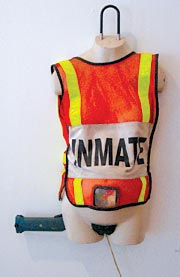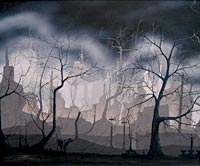As a public venue, the Asheville Area Arts Council’s various galleries are committed to exhibiting work by as many area artists as possible each year. As a result, artists are sometimes paired with others with whom they have little in common. But this isn’t the case with the current exhibition of works in the AAAC’s Front Gallery by Brian Mashburn and Sean “Jinx” Pace.

True, they use different media, and their formal concerns are vastly different. But on a conceptual level, the two mesh perfectly.
Don’t expect to skip blissfully down the street after you’ve seen the show; it isn’t intended to cheer you up. These young artists pull no punches on their view of what we’ve done to our environment and to our political position in the world.
Mashburn sometimes gives us bits of hope in his precisely rendered, but dismal, landscapes, while Pace’s work presents us with an irony that contains seeds of humor. Both look at their world head on, and there is no denial here—no “don’t worry, be happy” attitude. (The environmental themes will be familiar, for instance, to many of those who have suffered damage from mudslides caused by steep-slope grading.)
A great example: Mashburn’s “Blue Skies” are anything but blue. His illustrative style works well in this depiction of angular structures rising into a murky gray heaven. Trees, unseasonably stripped of their foliage, stand starkly against the foggy buildings. The sky has turned to vermilion in “Rubin,” and is bisected by turrets, spires and smoke stacks which seem to rise from dark cliffs of earth. In the barren gray foreground sits a lone dog staring pensively into space.
There is something erotic and seductive about these eerie landscapes. Coming upon such a place, one might be compelled to enter, even knowing that the result could be danger or even death.
The surrealism of Pace’s work is, at first glance, less ominous. His sculptures tend to look comfortingly like Dr. Seuss creations, but slowly the deeper meanings become clear. Pace carefully selects his materials to clarify his message, creating meaning out of well-placed elements of steel, AstroTurf, toys, mannequins and rubber chickens.
For instance, his “Death Slapper” consists of a steel frame, shaped much like a plane or helicopter. Cutouts of clouds and a cherub float along the body of the craft, and there is an elaborate arrangement of gears and pulleys leading to a motor. The propellers are made of rubber chickens, almost making the whole thing seem whimsical and amusing. Until, that is, you get to the skull fastened to the front of the machine, almost like the figurehead on the bow of a ship. It then becomes easy to think of so-called “collateral damage” caused by the machines of war in Afghanistan and Iraq.

“Inmate” is a work addressing many social issues. The piece is made from a female mannequin torso—no arms, no legs and no head—wearing the orange vest of a prison inmate who has been taken out to clean roadside litter. A triangle of bright green AstroTurf covers the pubic area, and a thick electrical cord attached to a well-used drill runs down from it. The belly is swollen and pregnant, and when you push the button of the drill, a small globe inside the belly rotates.
In a remarkably effective way, Pace has managed to talk about the justice system, overpopulation and women’s rights—all in one work.
And then there’s a less-likely theme: Birdcages manage to appear in both artists’ pieces. Mashburn paints a small one in his “Industricitis,” which lies on top of a garden cart in the foreground of a conglomeration of power poles and belching smoke stacks. The cage door is open, but the canary has died in the swirls of polluted air.
Meanwhile, Pace uses a big cage—one suitable for a parrot—in his “Close Captivity for the Living Impaired.” A toy bulldozer sits atop a mound of red dirt in the center of the cage. Someone bought this work, and Pace says that he just hopes they bought it as a work of art, and not because they needed a big bird cage.
[Connie Bostic is an Asheville painter and writer.]
New works by Sean Pace and Brian Mashburn can be seen at the Front Gallery of the Asheville Area Arts Council (11 Biltmore Ave.) through Wednesday, Aug. 29. AshevilleArts.com.



Not too sure about ‘Inmate’ but ‘Blue Skies’ is great! Reminds me of home. Keep it up.